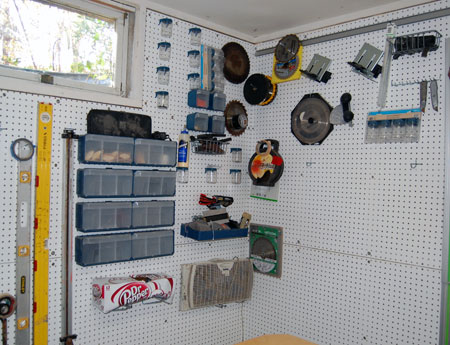
They say a man’s home is his castle, but for some, a home workshop is the real source of pride and joy.
For serious hobbyists like Hal McKusick and James Ledogar, their well stocked workshops are more than just places to while away the hours fiddling with tools, or a place to escape from the outside world. Their workshops are actual hotspots for productivity and passion.
Mr. McKusick’s more than 200-year-old woodworking space is a wooden, shingle-style structure filled with furniture, with natural wood walls, ceiling and floor. He previously ran his antiques and restoration shop, Little Barn Antiques, from the building and made special commission furniture pieces there.
Mr. Ledogar’s shop, which he built in 1986, is a modern and bright former garage where just about every tool imaginable is either on rollers or attached to the pegboard-faced walls. The former contractor, who now makes his living as a paramedic in Manhattan, used his workshop extensively when he built his house in 1986.
Mr. McKusick, a prominent jazz musician who composes music and plays more than a dozen instruments including the saxophone, clarinet, flute and piano, has been making furniture in his Sag Harbor-based woodworking shop for the last 37 years. The structure itself was originally built as a carriage house for the main residence—a parsonage—in 1796.
A self-taught woodworker, Mr. McKusick favors the Shaker-style of furniture and has made hundreds of pieces over his lifetime.
Inside the workshop, one finds seemingly every tool for woodworking known to man. Electric tools include a band saw, router, unisaw, drill press, an English mortising machine, planer, electric jig, lathe, tool sharpener and the necessary shop vacuum to suck up the massive amounts of sawdust and wood shavings created when making furniture.
Additional necessary hand tools and ancillary implements such as chisels, drill and router bits, measuring tools, wood clamps, biscuit joinery, sandpaper and more are also organized by usage and stored in cabinets.
There are also two vital items in Mr. McKusick’s shop that can’t be classified as tools, yet are still very important in his work, he said.
“These aren’t really tools, but no woodshop should be without a splinter remover and magnifying glass,” he said.
Some of the pieces Mr. McKusick has made in his woodshop, and which now furnish his home, include a Shaker side table made of curly cherry, Windsor chairs, a two-plank Shaker table, a curly cherry kitchen table and hutch, numerous storage pieces that he uses in his music studio and too many wooden bowls to count.
Though the number of his pieces is great, there is one thing they all have in common. The lifelong jazz man etches a musical note and some form of his name or initials on all of the pieces he creates.
Mr. McKusick said he prefers to work with wood in its natural state whenever he can find it. Assorted pieces of chopped wood stacked neatly in his workshop prove his statement.
“I’ve always loved wood,” Mr. McKusick said of his passion. “It’s a good feeling to take a piece of a tree and be able to make something beautiful from it.”
Though music has been his profession for practically his whole life—he’s worked alongside Billy Holiday, Dizzy Gillespie, Benny Goodman, Nat King Cole, Count Basie, Judy Garland, Barbra Streisand and many others—Mr. McKusick said that he gets almost as much pleasure from woodworking.
“Music and woodworking, these are two of the things that I love the most,” he said.
Over in Hampton Bays, Mr. Ledogar expressed a similar passion for his craft.
“I spend as much time in here as I can,” he said of his workshop. “For a home shop, it’s got pretty much everything I need to make whatever I want.”
Mr. Ledogar initially used his workshop as a command center and home-base when he built his house back in 1986. Now he uses the space primarily for making cabinetry, furniture and bookcases, doing home and sailboat maintenance projects and as an art studio for creating oil paintings.
Since he was once a professional contractor, Mr. Ledogar said he knows how to maximize the practical space of his shop. He stressed the importance of installing a floor that is durable, easy on the feet and legs, and is easy to clean. He also noted the importance of good ventilation for a home workshop, particularly when working with paints or other combustibles.
For maximum productivity and convenience, in Mr. Ledogar’s workspace, everything that is not hanging from the pegboard walls is on wheels and can easily be moved from one space in the shop to another.
“Everything should be on wheels ... The wheels make it easy to clean all the dust that will hide in the corners and behind things,” he said, adding, “I like peg boards and moveable metal shelves more than cabinets so I can see where everything is.”
Since he tries to spend approximately 20 hours a week in the space, the actual workshop is just as important to Mr. Ledogar as the projects he creates there. He has added special touches like color-block tiles on the floor and aluminum flashing for the baseboards. He has also hung large mirrors on the walls to create the illusion of more space than the 12-foot-by-31-foot room.
“It’s an ongoing project,” he said. “But it’s a nice place to stretch out and do work in.”
The larger tools of choice for Mr. Ledogar’s use are a table saw, compound mitre saw, a disc/belt sander and a vacuum/dust collector for cleaning up the remnants of his projects. Dozens of smaller hand tools such as hammers, wrenches, saws, drills, pliers and cleanup equipment are easy to locate hanging from the pegboard walls.
Mr. Ledogar has a piece of equipment in his shop that is not a tool, but is also necessary for working, and that piece of equipment is a radio. “You gotta have good music in the shop,” Mr. Ledogar said. “Good music is essential.”